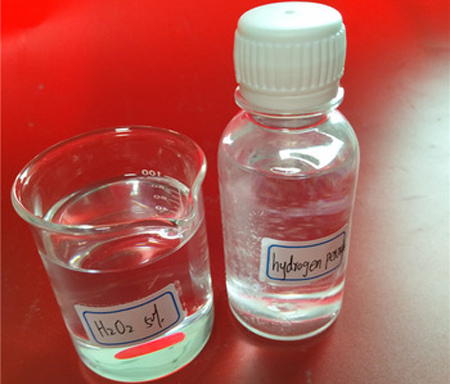Food Grade Hydrogen Peroxide: Top Uses, Benefits and More
You’re probably familiar with hydrogen peroxide and know it can be used to whiten teeth, sterilize a cut, or as a mouthwash. However, do you know about food grade hydrogen peroxide? Read on to learn about the basics, benefits, and uses of food grade hydrogen peroxide.

What Is Hydrogen Peroxide?
Hydrogen peroxide is a naturally acidic compound that has two hydrogens and two oxygens. It is stable in an acidic environment, and it releases and decomposes into oxygen gas inside the body.
Most people are familiar with three-percent hydrogen peroxide – the concentration typically found at the drugstore – and use it to clean wounds. However, there’s a 35-percent concentration of hydrogen peroxide that’s often referred to as food grade hydrogen peroxide.
3% vs. 35% Food Grade Hydrogen Peroxide
Three-percent hydrogen peroxide is the variety you’ve seen at your grocery store, and it is not recommended to take it internally. Thirty-five percent hydrogen peroxide is less commonly found on store shelves but is available online. It’s sometimes used by alternative medicine practitioners.
Three-percent hydrogen peroxide typically contains stabilizers like tetrasodium phosphate, sodium stannate, acetanilide, and phenol – none of which are good for you. Food grade hydrogen peroxide is pure and doesn’t contain stabilizers. However, it is caustic, and you still need to be careful with it.
For example, if you spill it on your fingers, it will turn your skin white, and you’ll experience what’s called a “hydrogen peroxide burn.” It goes away in a few hours, but be extremely careful – especially if you have children.
Regardless of the strength, you should never drink any undiluted hydrogen peroxide – even if it’s food grade. Also, you should not ingest large quantities of any hydrogen peroxide.
Benefits of Food Grade Hydrogen Peroxide
One of the best features of food grade hydrogen peroxide is that it’s a strong oxidant. So, whenever you have high levels of oxidants in your body, food grade hydrogen peroxide bonds to them to activate enzyme systems and stimulate oxygenation and detoxification.
Food grade hydrogen peroxide is healing, but it’s also a good idea to follow up with antioxidants when using it.
Some natural health practitioners use hydrogen peroxide or ozone therapies, then wait a couple of hours and administer high doses of vitamin C – a potent antioxidant (vitamin C is just one type of supplemental antioxidant that can be used). The oxygen grabs on to the positively charged toxins and harmful organisms. Drinking purified water and taking antioxidants helps to cleanse the body.
Uses of Hydrogen Peroxide
In the big cities of our modern world we’re constantly exposed to smog and different types of chemical residue. There’s mold, fungus, and other stuff floating around in the air. To help soothe the irritation those things cause, you can use a hydrogen peroxide sinus rinse.
You can mix six drops of 35-percent food grade hydrogen peroxide in about four ounces of water. Shake it up, and then put it in a nasal sprayer. It’s a really effective solution for flushing and soothing the sinuses.
Of course, that’s just one way to use hydrogen peroxide. Other common uses include:
• Mouthwash
• Toothpaste
• Teeth whitening
• Wound care
• Toothaches
• Colds
• Bad breath
• Acne
• Kitchen disinfectant
How Much Food Grade Hydrogen Peroxide Should You Take?
When you take food grade hydrogen peroxide, you should mix three drops with about eight ounces of water to dilute it. Do that two times per day, working yourself up if you’re going to be doing an oxygen infusion. The next day, you’ll mix six drops, and the following day you’ll mix 12 drops, and so on. However, you should never go above 20 to 25 drops twice per day.
Should You Mix It With Apple Cider Vinegar?
Food grade hydrogen peroxide can be mixed with organic raw apple cider vinegar because the apple cider vinegar is an acid, and hydrogen peroxide is stable in an acidic solution. Some people combine lemon juice, water, and a little hydrogen peroxide. You could use only organic apple cider vinegar which should be fine because acids help to stabilize reactive oxygen species.
Points to Remember
Hydrogen peroxide is a powerful natural remedy for many ailments. 35-percent food grade hydrogen peroxide does not contain stabilizers.
While hydrogen peroxide offers several benefits, keep in mind that it’s caustic. Be careful about drips and spills – especially if there are children around. Never drink undiluted hydrogen peroxide. Also, you should not ingest high quantities of any hydrogen peroxide.
Results may vary. Information and statements made are for education purposes and are not intended to replace the advice of your doctor. Our website does not dispense medical advice, prescribe, or diagnose illness. The views and nutritional advice expressed by us are not intended to be a substitute for conventional medical service. If you have a severe medical condition or health concern, see your physician.
yogaesoteric
December 4, 2019
